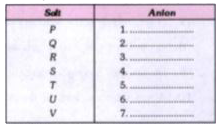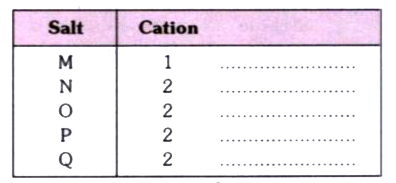Statement-1: Reaction of disodium hydrogen phosphate with magnesium sulphate in presence of ammonium hydroxide gives a white crystalline precipitate.
Statement-2:Insoluble magnesium ammonium phosphate is formed.
Statement-1 is True, Statement-2 is True, Statement-2 is a correct explanation for Statement-1
Statement-1 is True, Statement-2 is True, Statement-2 is NOT a correct explanation for Statement-1
Statement-1 is True, Statement-2 is False.
Statement-1 is False, Statement-2 is True.
The correct Answer is:A
To solve the question regarding the two statements about the reaction of disodium hydrogen phosphate with magnesium sulfate in the presence of ammonium hydroxide, we will analyze each statement step by step.
Step 1: Identify the Reactants
The reactants in the reaction are:
- Disodium hydrogen phosphate (Na2HPO4)
- Magnesium sulfate (MgSO4)
- Ammonium hydroxide (NH4OH)
Step 2: Write the Chemical Reaction
When these reactants are mixed, they undergo a double displacement reaction. The balanced chemical reaction can be written as:
Na2HPO4+MgSO4+2NH4OH→MgNH4PO4↓+Na2SO4+2H2O
Step 3: Identify the Products
From the reaction, we can see that the products formed are:
- Magnesium ammonium phosphate (MgNH4PO4), which precipitates out as a white crystalline solid.
- Sodium sulfate (Na2SO4)
- Water (H2O)
Step 4: Analyze Statement 1
Statement 1: "Reaction of disodium hydrogen phosphate with magnesium sulfate in presence of ammonium hydroxide gives a white crystalline precipitate."
- This statement is true because the product magnesium ammonium phosphate (MgNH4PO4) is indeed a white crystalline precipitate.
Step 5: Analyze Statement 2
Statement 2: "Insoluble magnesium ammonium phosphate is formed."
- This statement is also true because magnesium ammonium phosphate is known to be insoluble in water.
Step 6: Determine the Relationship Between the Statements
- Statement 2 provides a correct explanation for Statement 1, as it identifies the specific precipitate formed in the reaction described in Statement 1.
Conclusion
Both statements are true, and Statement 2 is the correct explanation for Statement 1.
Final Answer
- Statement 1: True
- Statement 2: True
- Statement 2 is the correct explanation for Statement 1.
---
The reactants in the reaction are:
- Disodium hydrogen phosphate (Na2HPO4)
- Magnesium sulfate (MgSO4)
- Ammonium hydroxide (NH4OH)
When these reactants are mixed, they undergo a double displacement reaction. The balanced chemical reaction can be written as:
Na2HPO4+MgSO4+2NH4OH→MgNH4PO4↓+Na2SO4+2H2O
From the reaction, we can see that the products formed are:
- Magnesium ammonium phosphate (MgNH4PO4), which precipitates out as a white crystalline solid.
- Sodium sulfate (Na2SO4)
- Water (H2O)
Statement 1: "Reaction of disodium hydrogen phosphate with magnesium sulfate in presence of ammonium hydroxide gives a white crystalline precipitate."
- This statement is true because the product magnesium ammonium phosphate (MgNH4PO4) is indeed a white crystalline precipitate.
Statement 2: "Insoluble magnesium ammonium phosphate is formed."
- This statement is also true because magnesium ammonium phosphate is known to be insoluble in water.
- Statement 2 provides a correct explanation for Statement 1, as it identifies the specific precipitate formed in the reaction described in Statement 1.
Both statements are true, and Statement 2 is the correct explanation for Statement 1.
- Statement 1: True
- Statement 2: True
- Statement 2 is the correct explanation for Statement 1.
Topper's Solved these Questions
Similar Questions
What products are formed ? When :
(i)Disodium hydrogen phosphate is added to magnesium sulphate in presence of ammonium chloride and aqueous ammonia.
(ii)A solution containing Zn2+ ions is poured in an aqueous ammonia.
(iii)Bi(NO3)3 solution is mixed with KI and then resulting precipitate is heated with water.
(iv)Disodium hydrogen phosphate is boiled with concentrated HNO3 and ammonium molybdate reagent.View SolutionThe presence of magnesium is confimed in the qualitative analysis by the formation of a white crystalline precipitate of :
View SolutionCalomel (Hg2Cl2) on reaction with ammonium hydroxide gives
View SolutionStatement-1 : Sodium meta aluminate on boiling with ammonium chloride produces white gelatinous precipitate.
Statement-2 :Aluminium hydroxide is formed which is not soluble in waterView Solution_____ solution will give a white precipitate with excess ammonium hydroxide solution?
View SolutionSalts P, Q,R,S,T,U and V undergo reactions (i) to (vii) respectively. Identify the cation present in these salts on the basis of these reactions. Tabulate your answer in the formate given below.
(i) When the salt Pis heated with sodium hydroxide solution a vigorous reaction takes place and a colourless gas is evolved with a pungent and suffocating smell that brings tears in our eyes. The evolved gas gives dense white fumes with a moist glass rod depped with hydrochloric acid.
(ii) Addition of sodium hydroxide solution to a solution of salt Q gives a thick white precipitae which is soluble in excess of sodium hydroxide solution to form a clear solution.
(iii) Addition of ammonium hydroxide solution to a solution of salt R gives a dark blue precipitate which is soluble is excess of ammonium hydroxide solution to form an intense deep blue solution.
(iv) Addition of ammonium hydroxide solution to a solution of 5 gives a dirty green [bottle green] precipitate which is insoluble even in the excess of ammonium hydroxide solution.
(v) Addition of ammonium hydroxide solution to a solution of T gives a reddish brown (rust precipitate] precipitate which is insoluble even in the excess of ammonium hydroxide solution.
(vi) Addition of ammonium hydroxide solution to a solution of V gives a geletaneous white precipitate which is soluble in excess of ammonium hydroxide solution to form a clear solution.
(vii) Addition of ammonium hydroxide solution to a solution of V gives no precipitate but it gives a chalky white precipitate with sodium hydroxide solution which is insoluble even in the excess of sodium hydroxide solution.
 View Solution
View SolutionIdentify the cation (positive ion) and anion (negative ion) in - 'A','B' & 'C'. Also identify P, Q, R, S, T, U, V, W.
a] Substance 'A' is water soluble and gives a curdy white precipitate 'P' with silver nitrate solution. 'P' is soluble in ammonium hydroxide but insoluble in dil. HNO3 . Substance 'A' reacts with ammonium hydroxide solution to give a white precipitate ' soluble in excess of NH4OH.
b] A solution of substance 'B' is added to barium chloride solution. A white ppt. 'R' is formed, insoluble in dil. HCl or HNO3 . A dirty green ppt. 'S' is formed on addition of ammonium hydroxide to a solution of 'B' and the precipitate is insoluble in excess of ammonium hydroxide.
c] Substance 'C' is a coloured, crystalline salt which on heating decomposes leaving a black residue 'T'. On addition of copper turnings and conc. H2SO4 to 'C' a coloured acidic gas 'U' is evolved on heating. A solution of'C' is added to NaOH soln. until in excess. A pale blue ppt. 'P' is obtained insoluble in excess of NaOH A solution of 'C' is then added to NH4OH soln. in excess to give an inky blue solution 'V'. A solution of 'C' is warmed and hydrogen sulphide gas is passed through it. A black ppt. 'W' appears.View SolutionA metal 'X' used to make calorimeters reacts with concentrated nitric acid to form a soluble salt Y. When few drops of ammonium hydroxide are added pale blue precipitates 'Z' are obtained. These precipitates dissolve in excess of ammonium hydroxide to form deep blue solution 'A'. Identify the metal X and give all the chemical equations.
View SolutionSalts M, N, O, P and Q undergo reactiom (i) to (v) respectively.
Identify the cation present in these salts on the basis of these reaction. Tabulate your answer in the format given below.
1. When sodium hydroxide solution is added to the salt M, and heated strongly a colourless gas with a pungent smell is evolved which turm red litmus paper blue and gives dense white fumes with a moist glass rod with hydrochloric acid.
2. Addition of dilute hydrochloric acid to a solution of N gives a thick white precipitate which is soluble in hot water.
3. When ammonium hydroxide solution is added to the solution of 0 a light blue precipitate is obtained which is soluble in excess of ammonium hydroxide to form an inteme deep blue solution.
4. When ammonium hydroxide solution is added to the solution of P reddish brown (mustard colour) precipitate is obtained which ,is insoluble even in the excess of ammonium hydroxide solution.
5. When sodium hydroxide solution is added to the solution of Q a which coloured gelatinous precipitate is obtained which is soluble in excess of sodium hydroxide to form a clear solution
 View Solution
View SolutionStatement-1:White precipitate of zinc phosphate is soluble in Ammonia.
Statement-2:Zinc phosphate forms a soluble complex with ammonia.View Solution

